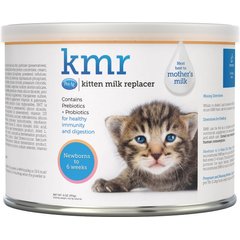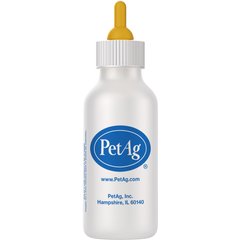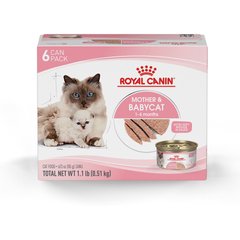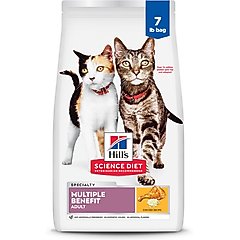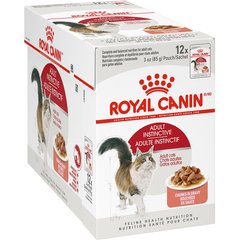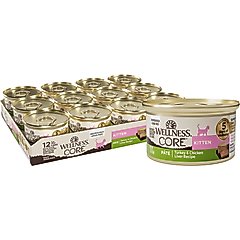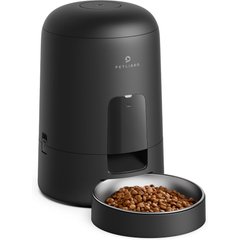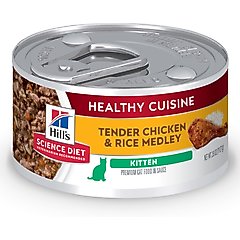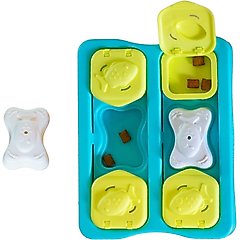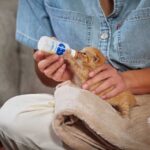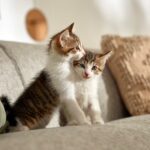How Much To Feed a Kitten
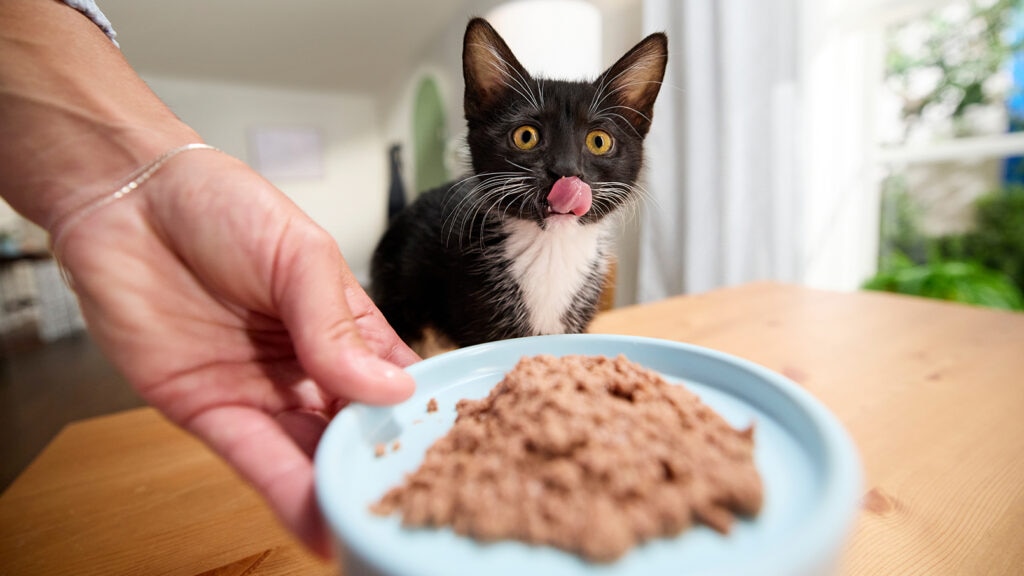
Photo by Chewy
Determining how much to feed a kitten isn’t easy. Even when you hit upon the right amount, it’s going to change before you know it because they just grow so fast.
Feeding your kitten the right amount of food is one of the best ways you can help them grow up to be a healthy and happy adult cat. Here’s how.
Key Takeaways
- Kittens need a diet formulated for growth and development by AAFCO standards.
- Feeding amounts depend on age, weight, and activity level.
- Very young kittens should be fed multiple small meals per day.
- As kittens grow, gradually adjust their feeding frequency and portions.
- Along with meals, always provide fresh water to your kitten.
When To Start Feeding Kittens
Age and size are the primary factors that affect how much to feed a kitten.
Feeding Newborn Kittens to 4 Weeks Old
Newborn kittens nurse frequently—approximately every two hours during the first week of life and then gradually decreasing to four to six times per day.
Daily weight checks are the best way to ensure they are getting all the food they need. Kittens should gain approximately a half to three-fourths of an ounce (15–20 grams) each day.
If young kittens can’t get adequate nutrition from their mother, they need to be supplemented with or switched to a high-quality kitten milk replacer, like PetAg KMR Kitten Milk Replacer Liquid, that’s bottle fed per the instructions on the label.
Recommended Products
Feeding Kittens at 4–6 Weeks Old
At about 3–4 weeks of age, kittens can start weaning or transitioning to solid food.
Several times a day, give them access to Royal Canin Mother & Babycat Ultra-Soft Mousse in Sauce Wet Cat Food or a gruel made from warm water mixed into a high quality canned kitten food.
Recommended Product
By 5–6 weeks of age, a gruel is no longer necessary because a kitten’s baby teeth are coming in and they can better chew their food.
Feeding Kittens at 6–8 Weeks Old
By the time kittens are 8 weeks old, they should be drinking water and completely eating on their own.
You can start offering dry kitten food at this point, but soaking it in a few tablespoons of warm water can help ease the transition.
Recommended Product
Most 8-week-old kittens weigh around 2 pounds, which means they should be taking in, on average, around 162 kilocalories/day (1 kilocalorie, or kcal, = 1 calorie).
Feeding Kittens at 8 Weeks to 10 Months Old
The most rapid period of growth occurs during the first six months of a cat’s life, after which their need for “extra” calories and nutrients starts to slow.
The kitten feeding chart below gives you a starting point for determining how much food to feed, but use your kitten’s body condition to make adjustments.
For example, if your cat has a body condition that is too thin, your veterinarian may recommend that your kitten consume more calories than what’s suggested for a kitten with an ideal body condition.
Feeding Kittens Over 10 Months Old
Most kittens can be switched to an adult cat food at around 10 months of age. Kitten food typically has more calories, fat, and proteins than cat food.
Recommended Products
Some cats, such as those who are naturally very petite or prone to weight gain, benefit from making the switch earlier. Others (large breeds, like Maine Coons, for example) should stay on kitten food for longer.
Your veterinarian can help you determine exactly when to switch from kitten to adult cat food and how much to feed your cat.
How Much To Feed a Kitten
Use your kitten’s weight to determine approximately how many calories they should be getting each day. Then, look at the label on your kitten food to see how many kcal/kg and kcal/can (wet food) or kcal/cup (dry food) it provides.
- Divide your kitten’s caloric needs (kcal/day) by the food’s caloric content (kcal/can or cup) to figure out how much of that food to feed your kitten each day.
- Divide this amount by the number of meals you plan to offer each day to get each meal’s serving size.
As an example, let’s say you have a kitten that is 5 pounds, and you feed them Wellness CORE Natural Grain-Free Canned Kitten Food. According to the chart, you should feed your kitten 327 kcal/day.
Recommended Product
Because the calorie content of the wet cat food is 108 kcal/can, you would determine how much wet food to feed your kitten by dividing 327 kcal/day by 108 kcal/can.
327 kcal/day ÷ 108 kcal/can = 3.027 cans of Wellness CORE Natural Grain-Free Canned Kitten Food per day.
Kitten Feeding Chart by Age
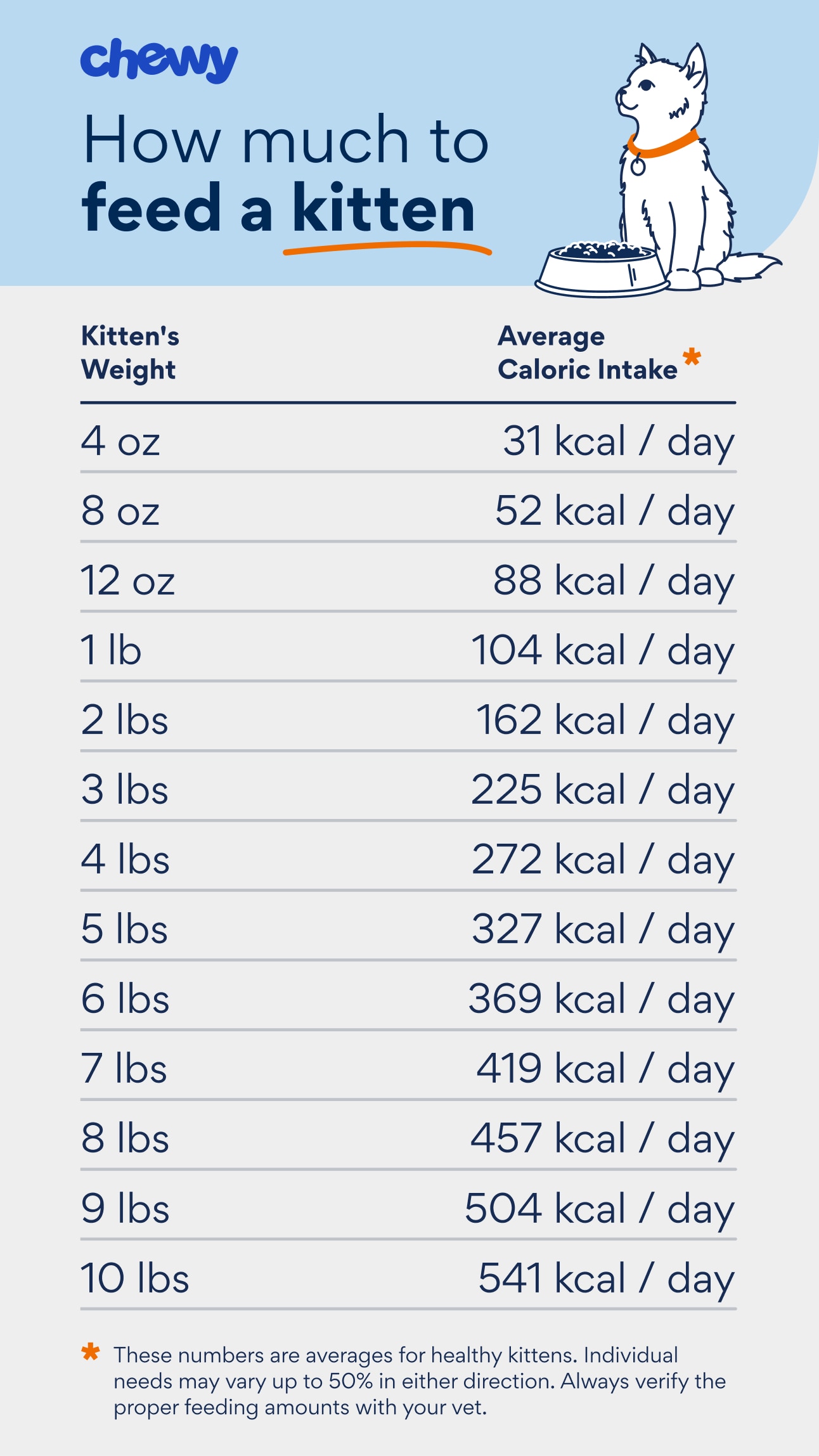
Photo by Chewy
Unsure how much wet food to feed a kitten? Or how much dry food to feed?
Below are averages for healthy kittens. Individual needs may vary up to 50 percent in either direction, so talk with your veterinarian to determine the proper food portions for your kitten.
| Kitten’s Age | Kitten’s Weight | Average Caloric Intake | Wet Kitten Food (Daily) | Dry Kitten Food (Daily) |
|---|---|---|---|---|
| Newborn | 4 oz (0.1 kg) | 31 kcal / day | 3 tbsp (KMR) | NA |
| 2 weeks | 8 oz (0.2 kg) | 52 kcal / day | 5 tbsp (KMR) | NA |
| 4 weeks | 12 oz (0.3 kg) | 88 kcal / day | 8 tbsp (KMR) | NA |
| 6 weeks | 1 lb (0.4 kg) | 104 kcal / day | 1 can | NA |
| 2 months | 2 lbs (0.9 kg) | 162 kcal / day | 1.5 can | 1/4 cup |
| 3 months | 3 lbs (1.4 kg) | 225 kcal / day | 2 cans | 1/3 cup |
| 4 months | 4 lbs (1.8 kg) | 272 kcal / day | 2.5 cans | 1/2 cup |
| 5 months | 5 lbs (2.3 kg) | 327 kcal / day | 3 cans | 1/2–2/3 cup |
| 6 months | 6 lbs (2.7 kg) | 369 kcal / day | 3.5 cans | 2/3 cup |
| 7 months | 7 lbs (3.2 kg) | 419 kcal / day | 4 cans | 3/4 cup |
| 8 months | 8 lbs (3.6 kg) | 457 kcal / day | 4 ¼ cans | 3/4–1 cup |
| 9 months | 9 lbs (4.1 kg) | 504 kcal / day | 4 2/3 cans | 3/4–1 cup |
| 10 months | 10 lbs (4.5 kg) | 541 kcal / day | 5 cans | 1 cup |
How Often To Feed Kittens
How many times a day should a kitten eat? Most kittens should have food left out throughout the day and night until they are 4–6 months of age.
If you want to feed both wet and dry, leave a high-quality dry kitten food out continually and offer two to three meals of wet kitten food each day, depending on the caloric needs of your kitten.
A kitten’s risk of unhealthy weight gain when fed free choice (meaning you leave the food out for them to graze) increases once they are 4–6 months old, especially if they are spayed or neutered. Unless your kitten is underweight, switching to a meal-based kitten feeding schedule is usually wise at about this time.
Here are some tips to keep in mind for your kitten’s feeding schedule:
- Cats naturally eat multiple small meals throughout the day.
- At a minimum, offer food to 4– to 6-month-old kittens three times daily.
- By 10 months of age, offer at least two meals per day—up to six small meals is even better!
Because most of us can’t maintain this type of schedule, consider using an automatic timed feeder, like the Petlibro Air Automatic Cat Feeder, which can be preloaded with six measured meals each day.
Recommended Product
Identifying how much food to feed a kitten is tricky, and you are not alone! Their needs change as they grow and can vary by as much as 50% in either direction from the average.
Getting portion sizes right from their earliest weeks can help to make sure your cat stays at a healthy body weight (neither too skinny nor too heavy).
As always, talk to your veterinarian if you have any questions or concerns.
What Do Kittens Eat?
Wet cat food has some significant nutritional advantages over dry cat food. But while most kittens benefit from a diet of wet canned food, there are advantages to feeding them dry food.
Wet Kitten Food vs. Dry Kitten Food
Cats are notoriously poor water drinkers, so feeding wet kitten food can help ensure that they remain well-hydrated.
High-quality wet kitten foods, like Hill’s Science Diet Kitten Healthy Cuisine, tend to contain more meat and protein and be lower in carbohydrates than dry foods, which better matches a kitten’s nutritional needs in comparison to dry.
Recommended Product
For these reasons, many veterinarians recommend that most, if not all, of a cat’s diet consist of wet food.
Dry kitten food, on the other hand, tends to be less expensive and can be left out for longer periods of time without spoiling.
Kibble can also be used in food puzzles, like the Catstages Kitty Cube, which provides both entertainment and exercise.
Recommended Product
Early in life, cats develop strong preferences for how food should taste and what it should feel like in their mouths.
Offer your kitten a variety of foods (for example, dry, wet, and different flavors and shapes) if you want to keep all your options open. However, you’ll have to keep exposing them to a variety of foods as an adult if you want to avoid food rejection in the future.
Be sure to talk to your veterinarian about the right mix of foods for your kitten.
When Can a Kitten Eat Adult Cat Food?
Kittens typically transition to adult cat food around 10 months old. That’s because at this age, adult cats no longer need the extra nutrients and calories found in kitten food.
